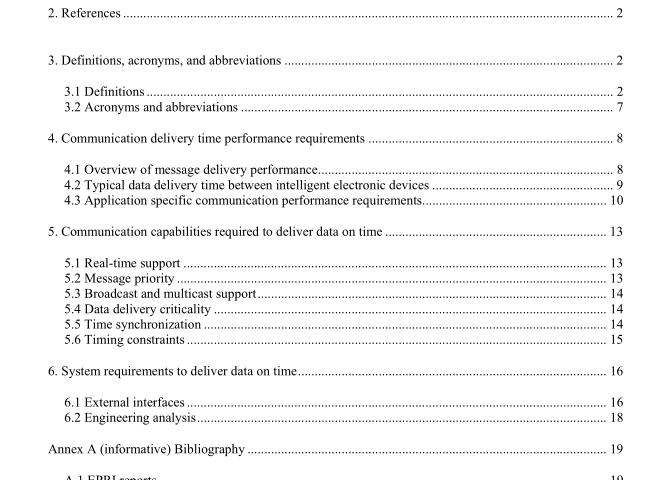IEEE 1646-2004 pdf download.IEEE Standard Communication Delivery Time Performance Requirements for Electric Power Substation Automation
2. References
This standard shall be used in conjunction with the following normative publications. When the referenced standard is superseded by an approved revision, the revision shall apply. IEEE Std 1588″-2002, IEEE Standard for a Precision Clock Synchronization Protocol for Networked Measurement and Control Systems.
3. Definitions, acronyms, and abbreviations
3.1 Definitions For the purposes of this standard, the following terms and definitions apply.
The Authoritative Dictionary of IEEE Standards, Seventh Edition [B7], should be referenced for terms not defined in this clause. The following conventions are used for cross-referencing: Contr: Refers to a term that has an opposed or substantively different meaning. See: Refers to a related term that has a similar, but not synonymous meaning. Syn: Indicates that the term has the same meaning as another term, which is referenced.
3.1.1 adjacent component protection: Protection of power system equipment at one substation based on data measured at others, e.g., line differential protection and teleprotection.
3.1.2 alarm processing: Alarm analysis procedures to improve presentation of alarm data. It ranges from updating alarm lists and producing group alarms up to more intelligent evaluations.
3.1.3 asynchronous transmission: In data communications, a method of transmission in which sending and receiving of data is controlled by control characters rather than by a timing sequence.
3.1.4 automatic switching sequences: Automatic sequential operation of groups of power system devices to reduce operator workload and/or switching time and to avoid unsuccessful or unnecessary switching attempts.
3.1.5 availability of data: State in which data are where the user needs them, when the user needs them, and how the user needs them.
3.1.6 breaker: A device that connects and disconnects power circuits, with faul-interrupting capability; Syn: circuit breaker.
3.1.7 breaker (health) monitoring: A function that measures a breaker’ s parameters for decisions on needed maintenance or repair.
3.1.8 breaker failure protection: Backup protection scheme to trip all connected breakers if a breaker fails to clear a detected fault.
3.1.9 broadband: Transmission that typically employs nondiscrete (analog) signals that are continuously
transmitted over a transmission media in the form of electromagnetic waves. Discrete information is encoded into analog waves by using amplitude, frequency, or phase modulation of the base (carrier) signal; Contr: baseband.
3.1.10 broadcast mode: Concurrent transfer mode of information to all connected receivers with one message from the information source; Contr: unicast mode; multicast mode.
3.1.11 calibrate function: Process of adjusting internal parameters of a measurement unit to reduce errors in its measured values.
3.1.12 client: (A) A system entity (combination of hardware and software components) which requests particular services to be done on its behalf from another entity (i.e, the server); (B) An intelligent electronic device (IED)
object that requests information from, or invokes the procedures, of another (i.e.. the server).
3.1.13 cold load pickup: Restoration of a circuit where all load diversity is lost.
3.1.14 communication interface: Serial interface of a device that allows exchange of (physical and logical)
information among devices of the same or different functional levels in a hierarchical system. An interface specifies the connection of a communication link, with regard to the mechanical connection as well as to the signal’s physical and functional characteristics.
3.1.15 communication safety: Measures and controls to avoid any deterioration or losses of information (reliability).
3.1.16 device: Physical entity connected to the communication network composed of at least one communication element (the network element), which may have a control element, and/or a monitoring element (transducer,actuator, etc.).
3.1.17 digital fault recorder (DFR): Device that samples and stores analog and related binary data during power system transients; Syn: Transient fault recorder (TFR).
3.1.18 disconnect switch: Device that connects and disconnects de energized power circuits; Syn: isolator.
3.1.19 equipment clock sy nchronization: Automated procedure to maintain consistent time data throughout the substation or power system; e.g.. for time tagging or synchronized sampling.
3.1 .20 equipment load monitoring: Automated procedures to detect equipment overload. The goal is to tolerate temporary overload, support for adaptive protection and maintenance on request.
3.1.21 fault isolation: A procedure to operate fer-ectionalizing switches (isolators) to disconnect a faulted feeder section.
3.1.22 fault recording: Process for cllction, storage and analysis of power system fault data.
3.1.23 feeder fault isolation: A procedure to disconnect the power network device (transformer, busbar,switchgear, etc.) in which a fault has occurred.
3.1.24 feeder switching: A procedure to manage feeder connectivity changes; See also: automatic switching sequences.
3.1.25 generator protection: Function of protecting generator from fault and abnormal operating conditions.
Copyright◎2005 IEEE. All rights reserved.IEEE 1646 pdf download.IEEE 1646-2004 pdf download
IEEE 1646-2004 pdf download

Leave a Reply